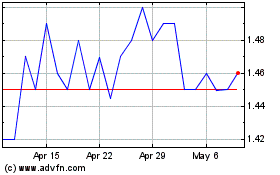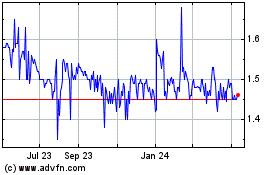Equus Shareholders Grant Authorization to Withdraw BDC Election and Increase Borrowing Capacity
November 19 2019 - 7:03PM

Equus Total Return, Inc. (NYSE: EQS) (“Equus” or the “Company”)
today announced that its shareholders have authorized the Company’s
Board of Directors (hereinafter, the “Board”) to: (i) cause the
Company’s withdrawal of its election to be classified as a business
development company (“BDC”) under the Investment Company Act of
1940 (the “1940 Act”) as part of a potential strategic
transformation of Equus into an operating company or a permanent
capital vehicle; and, to the extent Equus remains a BDC, (ii)
increase the Company’s borrowing capacity under the 1940 Act for
additional portfolio investments.
The authorization to withdraw the Company’s BDC election, which
expires on March 31, 2020, is a consequence of the Company’s Plan
of Reorganization announced on May 15, 2014 (also referred to
herein as the “Plan”). In announcing the Plan, Equus stated its
intention to implement the Plan which entailed, among other things:
(i) the restructuring of the Company by way of an acquisition of,
or merger with, an operating company, and (ii) a withdrawal of the
Company’s election to be classified as a BDC. Although Equus has
been authorized to withdraw and terminate the Company’s BDC
election under the 1940 Act, it will not submit any such withdrawal
unless and until Equus has entered into a definitive agreement to
acquire an operating company or qualify as a permanent capital
vehicle.
The authorization to increase the Company’s borrowing capacity
is a consequence of the Small Business Credit Availability Act
(“SBCAA”) which was signed into law in March 2018 and amends
certain sections of the 1940 Act applicable to BDCs. Pursuant to
the SBCAA, a BDC may be authorized by its board or its shareholders
to decrease its asset coverage ratio from 200% to 150%, the effect
of which is to double the potential borrowing capacity of BDCs. The
SBCAA requires a one-year waiting period to decrease the ratio if
authorized solely by a BDC’s board of directors, but such decrease
may be implemented immediately if authorized by its shareholders,
as in the case of Equus.
Equus management regularly reviews and evaluates the Company’s
performance, prospects and long-term strategic plans in light of
the Company’s business and the industries in which it invests, and
then makes recommendations to the Board of Directors. Over the past
several years, the Company has examined a number of potential
transactions in a variety of industries, including energy, natural
resources, containers and packaging, real estate, media,
technology, and telecommunications. These reviews have included
consideration of potential strategic transactions to maximize value
to shareholders as an operating company or a permanent capital
vehicle not subject to the 1940 Act, as well as potential
investments that could be made while continuing as a BDC, but which
would require more borrowing capacity than has previously been
possible for Equus. The pursuit of these growth strategies has
culminated in the authorization granted by the Company’s
stockholders to the Board to: (i) withdraw the Company’s BDC
authorization as part of a potential strategic transformation of
Equus into an operating company or a permanent capital vehicle and,
to the extent Equus remains a BDC, (ii) increase the Company’s
borrowing capacity for additional portfolio investments.
Potential Advantages
An operating company structure, in lieu of a closed-end fund
structure, could be advantageous to Equus and its shareholders in
various ways, including: (i) a wider range of growth opportunities
through merger with and acquisition of other operating companies,
(ii) a valuation of Equus based on typical operating criteria such
as earnings, revenue, and gross profit, instead of net asset value,
(iii) lower proportional compliance costs due to Equus not being
regulated under the 1940 Act, and (iv) greater flexibility to issue
common and preferred equity, as well as other types of securities
as consideration for acquisitions and growth of the Company.
To the extent that Equus remains a BDC, an increase in the
Company’s borrowing capacity could be advantageous to Equus and its
shareholders to: (i) enable the Company to participate in a wider
variety of potential investments, some of which could involve debt
securities issued by Equus as part of the consideration for the
investment, and (ii) potentially improve returns to stockholders by
increasing the assets under management and generating returns on
these assets in excess of the Company’s borrowing costs.
Moreover, the Company believes that it could gain cost
efficiencies in managing a greater number of assets such that Fund
expenses as a percentage of assets under management would decrease.
In recent years, Fund management has made significant efforts to
decrease overall costs and costs relative to its net asset value
including, for example, reductions in staff and in the number of
members of the Company’s Board.
Risks and Uncertainties
The transformation of Equus into an operating company or the
continuation of Equus as BDC with increased borrowing capacity are
each subject to various conditions, risks, and uncertainties. Such
risks should be considered in addition to the items identified as
“Risk Factors” in the Company’s most recent Annual Report on Form
10-K filed with the Securities and Exchange Commission (the “SEC”)
on March 29, 2019.
Forward-Looking Statements
This press release contains certain forward-looking statements
regarding possible future circumstances. These forward-looking
statements are based upon the Company’s current expectations and
assumptions and are subject to various risks and uncertainties that
could cause actual results to differ materially from those
contemplated in such forward-looking statements including, in
particular, the performance of the Company, including our ability
to achieve our expected financial and business objectives, our
ability to execute our reorganization (including a possible
Consolidation) and complete the transactions contemplated thereby,
our ability to secure additional borrowings as authorized by our
shareholders, the other risks and uncertainties described herein,
as well as those contained in the Company’s filings with the SEC.
Actual results, events, and performance may differ. Readers are
cautioned not to place undue reliance on these forward-looking
statements, which speak only as to the date hereof. The Company
undertakes no obligation to release publicly any revisions to these
forward-looking statements that may be made to reflect events or
circumstances after the date hereof or to reflect the occurrence of
unanticipated events. The inclusion of any statement in this
release does not constitute an admission by the Company or any
other person that the events or circumstances described in such
statements are material.
Contacts:
Patricia Baronowski Pristine Advisers, LLC (631) 756-2486
Equus Total Return (NYSE:EQS)
Historical Stock Chart
From Mar 2024 to Apr 2024

Equus Total Return (NYSE:EQS)
Historical Stock Chart
From Apr 2023 to Apr 2024
